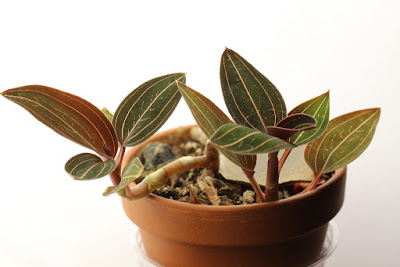Ludisia discolor is widespread, ranging from northern India, through southeast Asia, north to southwestern China and south through Malaysia up to Indonesia. In China, it is found in swampy places in the forests, at heights of 950-1000 m...
Ludisia discolor also called as The Jewel Orchid, The Variegated Ludisia, The Twisted Flower Orchid, The Rock Silk Worn, The Rock Lotus Root, Anoectochilus dawsonianus, Anoectochilus ordeanus, Anoectochilus ordianus, Gonogona discolor, Goodyera dawsoniana, Goodyera discolor, Goodyera ordeana, Goodyera ordiana, Goodyera rodigasciana, Goodyera rubrovenia, Haemaria dawsoniana, Haemaria discolor, Haemaria discolor var. concolor, Haemaria discolor var. condorensis, Haemaria discolor var. dawsoniana, Haemaria discolor var. denisoniana, Haemaria discolor var. grandis, Haemaria discolor var. ordeana, Haemaria discolor var. rhodoneura, Haemaria discolor var. trilineata, Haemaria otletae, Haemaria pauciflora, Haemaria rubrovenia, Kuhlhasseltia carrii, Ludisia dawsoniana, Ludisia discolor var. ordiana, Ludisia furetii, Ludisia odorata, Ludisia otletae, Myoda rufescens, Neottia discolor, Orchiodes discolor, is a species of the genus Ludisia. This species was described by Achille Richard in 1825.
IDENTIFY LUDISIA DISCOLOR
Ludisia discolor is widespread, ranging from northern India, through southeast Asia, north to southwestern China and south through Malaysia up to Indonesia. In China, it is found in swampy places in the forests, at heights of 950-1000 m, in the provinces of Yunnan, Guangxi, Guangdong and Hainan. There are reports of their finding in many mountain areas of Vietnam, from Cha Pa in the north to Dalat in the south, but only one height of the natural habitat is given, 1200 m.
It is a small sized, hot to warm growing, terrestrial or lithophytic plant, which rarely reach more than 15 cm in height, without pseudobulbs, the fleshy red stems twisted, erect or pendulous are 20 to 25 cm long and have stalked elliptic-lanceolate, over 7.5 cm in length and 4.3 cm in width leaves.
The Jewel Orchid blooms in the spring on a terminal cylindrical fairly dense 10 to 30 cm long inflorescence that has small asymmetrical, fragrant flowers that last 2 to 3 weeks. The white flowers are about 2 cm in diameter, and the cover of the pollen chamber has a bright yellow color. The outer whorls are about 1 cm long and 0.5-0.7 cm wide. The dorsal petal together with the inner whorl flakes form a hood that bends forward over the backbone and the lateral outer petals curl forward, slightly towards the tops. This results in a cup-shaped flower. The lip is twisted counterclockwise, the bag is at the base and has a transversely spread plaque with a length of about 0.5 cm and a width of 0.8 cm. The spine is twisted clockwise, that is opposite to the lip, there are no wings or other appendages in front.
LUDISIA DISCOLOR CARE AND CULTURE
Cultural information should only be used as a guide, and should be to be adapted to suit you. Your physical location; where you grow your plants, how much time you have to devote to their care, and many other factors, will need to be taken into account. Only then can you decide on the cultural methods that best suit you and your plants.
Light:
Ludisia discolor needs a light level of 8000-15000 lux. The light should be well filtered and dispersed, and the plants should not be exposed to direct sunlight. Strong air movement should be ensured all the time.
Temperature:
It is a thermophilic plant. In summer, the average day temperature is 27 ° C, the night 21-22 ° C, which gives a daily difference of 6 ° C. In winter, the average day temperature is 15-18 ° C, at night 9-12 ° C, with a daily amplitude of 6 ° C.
Humidity:
The Jewel Orchid needs the humidity of 85-90% throughout the year.
Substrate, growing media and repotting:
The creeping habit of Ludisia discolor forces cultivation in shallow bowls with good drainage, filled with a very loose, quickly drying ground, such as medium granulation bark or chopped tree fern fibers. Also, materials that release the substrate but often retain a portion of the moisture, e.g. perlite and cut sphagnum moss, are often added to such a mixture. Wood charcoal is also often added to ensure the air permeability of the substrate and protection against acidification.
The plants should be repotted when the substrate begins to decompose or grow out of the pots. If repotting is done at the time when new roots begin to appear, the plant will be accepted and rooted in the shortest possible time. These plants relatively easily reproduce from pieces of stem.
Watering:
Rainfall is very abundant for most of the year, with a 2-3-month slightly drier period in winter. The cultivated plants in the phase of active growth should be frequently watered, but they should slightly dry out between waterings and you can never allow the substrate around the roots to be stale or soaked. When new growths reach maturity in the autumn, the amount of water should be gradually reduced.
Fertilizer:
During the active growth, the plants should be fertilized every week 1/4-1/2 of the recommended dose of fertilizer for orchids. You can use balanced fertilizer throughout the year, but can also use fertilizer with increased nitrogen content from spring to mid summer, and then in the late summer and autumn, use a fertilizer with a higher content of phosphorus.
Rest period:
In winter watering of Ludisia discolor should be limited, especially those grown in colder conditions, but it is not allowed to dry excessively or remain dry for a long time. Fertilization should be reduced or completely eliminated until more intense watering starts in the spring.















COMMENTS